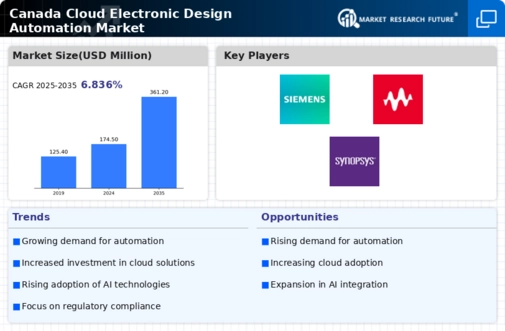Advancements in Technology
Technological advancements are significantly influencing the cloud electronic-design-automation market in Canada. Innovations in cloud computing, such as enhanced processing power and improved data storage solutions, are enabling more complex electronic designs to be executed efficiently. The integration of advanced simulation tools and high-performance computing capabilities within cloud platforms is attracting a wider range of users. As technology continues to evolve, it is anticipated that the cloud electronic-design-automation market will expand, with new features and functionalities being introduced regularly. This trend suggests that companies will increasingly rely on cloud-based solutions to stay competitive in a rapidly changing technological landscape.
Increased Investment in R&D
Investment in research and development (R&D) is a pivotal driver for the cloud electronic-design-automation market in Canada. Companies are allocating substantial resources to innovate and enhance their electronic design capabilities. This trend is reflected in the growing number of startups and established firms investing in cloud-based EDA solutions. Recent statistics indicate that R&D spending in the technology sector has increased by over 15% in the past year, highlighting a commitment to advancing electronic design technologies. As organizations prioritize innovation, the cloud electronic-design-automation market is likely to benefit from an influx of new ideas and solutions, fostering a competitive environment.
Cost Efficiency and Scalability
Cost efficiency remains a critical driver for the cloud electronic-design-automation market in Canada. Organizations are increasingly recognizing the financial benefits of cloud solutions, which eliminate the need for extensive on-premises infrastructure. By leveraging cloud-based electronic design automation tools, companies can reduce operational costs by up to 30%. Furthermore, the scalability offered by cloud solutions allows businesses to adjust their resources according to project demands, ensuring optimal utilization of assets. This flexibility is particularly appealing to small and medium-sized enterprises, which may lack the capital for large-scale investments in traditional EDA tools. As a result, the cloud electronic-design-automation market is likely to see continued growth fueled by these cost-effective solutions.
Regulatory Compliance and Standards
Regulatory compliance is becoming an essential driver for the cloud electronic-design-automation market in Canada. As industries face increasing scrutiny regarding data security and privacy, organizations are compelled to adopt cloud solutions that adhere to stringent compliance standards. The cloud electronic-design-automation market is responding to this need by offering tools that ensure compliance with local and international regulations. This focus on regulatory adherence not only mitigates risks but also enhances the credibility of cloud-based solutions among potential users. Consequently, the demand for compliant cloud electronic-design-automation tools is expected to rise, further propelling market growth.
Growing Demand for Remote Collaboration
The cloud electronic-design-automation market in Canada is experiencing a surge in demand for remote collaboration tools. As organizations increasingly adopt hybrid work models, the need for efficient design collaboration has become paramount. This shift is driving the adoption of cloud-based solutions that facilitate real-time collaboration among geographically dispersed teams. According to recent data, the market for remote collaboration tools is projected to grow by approximately 25% annually, indicating a robust trend towards cloud solutions in electronic design. This growing demand is likely to enhance the capabilities of the cloud electronic-design-automation market, enabling engineers to work seamlessly across various platforms and devices.














Leave a Comment